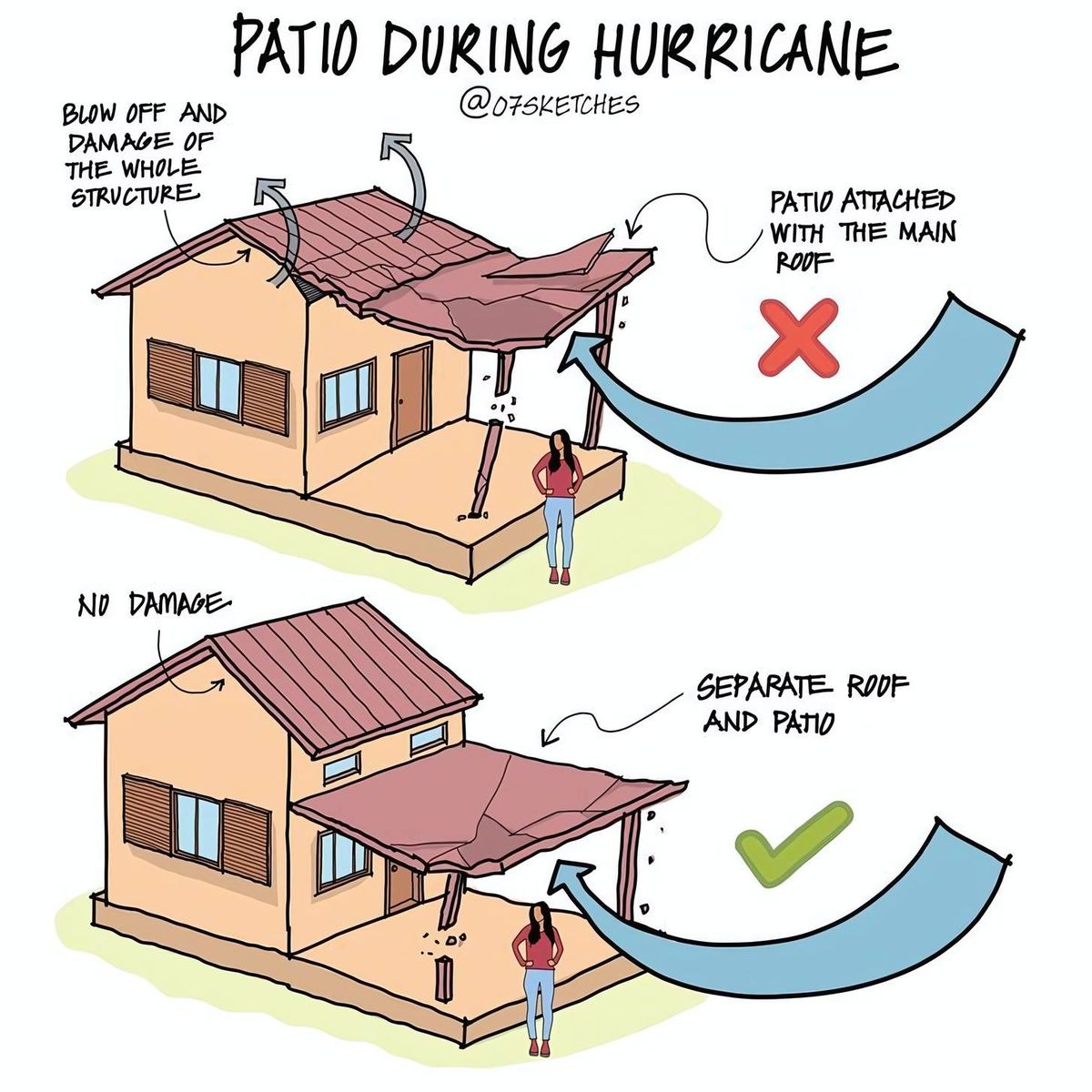
A simple but powerful diagram by the design account @07sketches is providing a critical, potentially home-saving lesson for anyone living in a storm-prone region. It clearly illustrates how a seemingly minor decision—the way a patio cover is attached to a house—can be the difference between a manageable repair and a catastrophic roof failure during a hurricane or other high-wind event.
The image is a vital public service announcement, revealing a common construction mistake and the simple, resilient solution that can protect your home’s primary structure when it matters most.
## The Critical Mistake: The Integrated Roof
The top half of the diagram, marked with a red ‘X’, shows a very common method for building a covered patio or carport. The rafters and sheathing of the patio roof are tied directly into the framing of the main house roof. While this can create a clean, seamless look, it creates a dangerous structural dependency.
A Step-by-Step Failure in High Winds:
- Aerodynamic Lift: During a hurricane, the large, relatively flat surface of a patio roof acts like an airplane’s wing. The high-speed wind rushing over the top creates a low-pressure zone, while the wind trapped underneath creates a high-pressure zone. This pressure differential generates an immense upward force known as aerodynamic lift.
- A Chain Reaction: Because the patio roof is structurally part of the main roof, this violent lifting force is transferred directly to the primary structure of the house. The weaker patio addition doesn’t just fail on its own; it acts as a giant lever, tearing the main roof trusses, sheathing, and shingles right off the house along with it.
- Catastrophic Damage: As the diagram shows, the failure of the less-critical patio roof leads to the “blow off and damage of the whole structure.” This rips a massive hole in the home’s primary defense against the storm, exposing the interior to wind and torrential rain, which can lead to devastating and costly water damage.
## The Smart Solution: Structural Separation
The bottom half of the diagram, with its green checkmark, illustrates the far superior and more resilient approach, a principle known as structural separation or “sacrificial design.”
A Step-by-Step Success Story:
- The Design: The patio is built with a separate roof. Its support structure is anchored securely to the strong, vertical wall of the house (typically with a heavy-duty ledger board and structural bolts), but it is not connected to the trusses or framing of the main roof. It is an independent structure.
- A Controlled Failure: In the same powerful storm, the wind generates the same immense lift force on the patio roof. The patio roof may still be damaged or even completely torn away. However, because it is a separate structure, it fails on its own.
- The Main Structure Is Saved: As the diagram shows, the primary roof of the house remains completely intact, suffering “No damage.” The home remains secure and weatherproof, protecting the family and their belongings inside.
In this scenario, the patio roof is “sacrificed” in an extreme weather event to ensure the safety and integrity of the main home. The homeowner is left with the much more manageable and less expensive task of repairing or replacing a patio cover, not rebuilding a major part of their house.
## Conclusion: Build for Resilient, Not Rigid, Connections
“This diagram perfectly illustrates one of the most important principles of disaster-resilient design,” says Dr. Marcus Thorne, a (fictional) structural engineer and mitigation consultant. “You always want the weakest link in a chain to be the least important part. Tying a large, vulnerable appendage like a patio roof directly to your primary roof structure is a classic mistake. It ensures that when the weak link fails, it takes the whole system down with it.”
For homeowners in regions prone to hurricanes, tornadoes, or other high-wind events, this is a crucial piece of knowledge. Before building a new patio, carport, or porch, have a discussion with your contractor about using a structurally separate design. It’s a small change in technique that can make a massive difference in how your home weathers the storm.